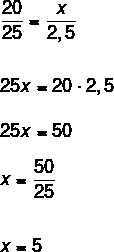THE proportion consists of the equality between two or more reasons, which are the division between numbers in which we must obey the order in which they are placed. For example, in the Fibonacci sequence, the reason between any term and its predecessor will always be proportional, that is, equal. The study of proportions is very important, since, in nature and in our daily lives, this concept appears frequently.
Read too: Rule of three: how to calculate?
ratio and proportion
To better understand the definition of proportion, it is first necessary to know what a reason is. One reason is nothing more than the quotient between the numbers involved in the operation, see:
Definition of reason
Let a and b be any two numbers, with b ≠ 0, its ratio is given by division between both:

Example
Determine the ratios between 2 and 3; 7 and 9; 4 and 18. For this, we must write the fractions (divisions) between the numbers in question in the order they were placed.

When we equate two ratios, we are establishing a ratio.
definition of proportion
Let the numbers a, b, c and d, with b ≠ 0 and d ≠ 0, the ratio between them, in that order, form a proportion, that is:

If the equality is true, that is, if a · d = b · c, then the numbers a, b, c and d are proportional.
Example
Check whether the numbers below are proportional or not.
a) 2, 4, 8 and 16
For these numbers to be proportional, the ratios between them must be equal, let's check.

Note that, after assembling the ratios, we simplify the fractions and get two of them, so the numbers are proportional. Another way to check if they are proportional is to perform the multiplication cross, Look:

After cross-multiplication, if the equality is true, the numbers are proportional. You can choose which method you think is best for the verification, in the example below, we will only use cross multiplication, see:
b) 3, 5, 2, 3
We set up the ratios and then cross-multiply.

See that equality no is true, so the numbers are not proportional.
Read too: Fraction simplification: what is it and how to do it?
difference between ratio and proportion
Knowing the definitions of ratio and proportion, we can now understand the difference between them. The reason is the division between two known numbers, and the proportion is the equality between those numbers.
Proportion Properties
The proportion has some properties that can facilitate the resolution of some problems, however, the first two deserve special attention. See, below, what they are.
Property 1 - Consider the proportion:

So the next equality is true:

Property 2 - Also known as fundamental property of proportions.

For all of the following properties, consider the definition of aspect ratio.
Property 3 - The ratio between a and c is equal to the ratio between a + c and b + d.

Property 4 - Given the definition of proportion, then the following equality is true.


solved exercises
question 1 - (Unicamp - SP) The ratio between Pedro's age and that of his father is equal to two ninths. If the sum of the two ages equals 55 years, then Pedro has:
a) 12 years
b) 13 years old
c) 10 years
d) 15 years
Solution
Alternative c.
Since we don't know the ages of Peter and his father, let's call them x and y, respectively.
x → Peter's age
y → father's age
The ratio between the age of Pedro and his father is equal to two-ninths, see that we have an equality between reasons, therefore, a proportion.

According to the statement, we have that the sum of the ages is 55, so:
x + y = 55
Now, using property 4 of the proportion, we have:

question 2 - It is known that the numbers 20, 25, x and 2.5 are proportional in that order. Determine the value of x based on this information.
Solution
As the numbers are proportional in a certain order, then we have the following proportion (after mounting it, we use property 2):



